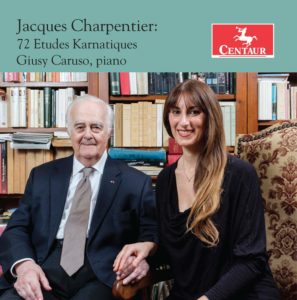The late Jacques Charpentier (1933-2017) was a disciple of Olivier Messiaen who shared his mentor’s interest in how the spiritual and musical substance of Indian classical music can inform a creative process rooted in Western traditions. Among his more than 150 works, the Etudes Karnatiques for solo piano may be the most ambitious. It consists of 72 studies that respectively correspond to the 72 scales or “ragas” comprising South Indian Karnatic traditions. Charpentier began the project in 1957, and worked periodically on it until its completion in January 1985, ultimately yielding three hours’ worth of music.
The etudes are partitioned into twelve separate cycles, each containing six etudes. Three of the twelve cycles (Nos. 2, 8, and 12) are meant to be played as a single entity, going directly from one etude to the next. Despite the nearly 30-year compositional span, there’s a remarkable consistency in style from etude to etude, as well as a wide variety of moods. Although Charpentier’s asymmetric phrases and thick sequences of chords take their cue from the Messiaen playbook, the motoric dance rhythms and use of subtle repetition suggest a rather far-fetched Prokofiev and Bartók meet Minimalism scenario. Yet Charpentier’s original voice makes itself felt in the long run.
The composer himself recorded a small selection of these etudes for Philips in the late 1960s, while Anne Gaels became the first to record all 72 around 1995. Her composer-supervised cycle appeared on the small 3D Classics label. Genuin released the cycle’s second integral recording in 2012, featuring Michael Schäfer, a brilliant virtuoso whose discography includes numerous repertoire rarities. Now Centaur brings out a third contender with the Milanese/Brussels-based pianist Giusy Caruso. It documents a complete and apparently unedited live performance that took place in Carcassonne, France on November 26, 2016 in the presence of the composer, with whom she coached the etudes. She also prepared her interpretations by making an intensive study of Karnatic performance practice in order to gain understanding and internalize the inflections, nuances, and gestures that influenced Charpentier’s sound world. As a result, Caruso channels her virtuosity toward a more vocally-oriented, dance- informed aesthetic.
For example, in Rhatnangi, the second etude of the first cycle, Schäfer sprints through the relentless octaves with impressive power and drive. Caruso’s slower tempo, by contrast, allows the inner rhythms and melodic curves to register and take shape. Schäfer brings steely security and centered poise to Suryakanta’s chattering patterns, whereas Caruso’s touch is lighter and her articulation more varied. In Naganandini, Schäfer’s smoothly dispatched single lines differ from how Caruso underlines the harmonic movement by holding certain notes a split second longer than written, creating momentary overlapping effects. Caruso also balances Syamalangi’s procession of slow moving chords less uniformly. In essence, both Schäfer and Caruso aim at different things.
Sonically speaking, Caruso’s closely miked archival recording places the listener virtually inside of her piano, which doesn’t allow the music’s loudest moments to resonate and congeal to best effect. And given that we’re hearing three hours of music in a single shot, the piano’s tuning inevitably slips in places. Before each etude, Caruso plays the scale on which that etude is based. Apparently the composer encouraged her to do so, but I find that it dissipates the music’s potential to create a large-scale arc and momentum when heard in one fell swoop.
Notwithstanding these small caveats, I lean toward Caruso’s persuasive conceptions, not to mention her formidable technical mastery, her impressive stamina, and her fervent commitment to the material. For virtuosity per se, Schäfer has the advantage of superior engineering. So does Anne Gael, whose interpretations more-or-less split the difference between Schäfer and Caruso. Unfortunately, Gael’s recording, which includes an interview with the composer in French, is long out-of-print and extremely difficult to source. In any event, I hope that Caruso’s recording will convince listeners and pianists alike about the Etudes Karnatiques’ scope and significance.
































